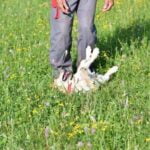Are you wondering how to train your dog not to jump the fence? Many dog owners face the challenge of dealing with a furry escape artist attempting to leap over boundaries. Understanding the root cause of why dogs jump fences and the behavioral factors involved is crucial in addressing this issue effectively.
Exploring why dogs exhibit this behavior can shed light on potential solutions. Establishing clear and consistent boundaries for your dog is essential in preventing fence jumping. Positive reinforcement training methods can also be used to discourage fence jumping behavior, promoting a positive and loving relationship between you and your pet.
Incorporating regular exercise and mental stimulation can help keep your dog occupied and less inclined to jump the fence. By monitoring your dog’s behavior and correcting them when they show signs of fence jumping, you can effectively address this issue.
Making environmental modifications such as changes to your yard or fence may also deter your dog from attempting to jump. Knowing when to seek the assistance of a professional dog trainer or behaviorist is important, as consistency and patience are key in effectively training your dog not to jump the fence.
Setting Boundaries
When it comes to training your dog not to jump the fence, one of the most crucial steps is setting clear and consistent boundaries. Dogs thrive on structure and rules, so it is important to establish and enforce these boundaries from the beginning. Here are some key strategies for setting boundaries for your dog:
- Define the perimeter: Determine the specific area where you do not want your dog to jump or cross over. Use visual markers or physical barriers to clearly establish this boundary.
- Consistency is key: Communicate the boundaries to all members of your household, as well as visitors. Everyone should be on the same page when it comes to enforcing these restrictions.
- Use positive reinforcement: When your dog respects the set boundaries, reward them with praise, treats, or playtime. This will help reinforce their understanding of where they are allowed to be.
It’s important to note that setting boundaries also involves providing alternative outlets for your dog’s natural behaviors. For example, if your dog likes to explore, provide them with a designated area in your yard where they can dig or investigate without needing to jump the fence.
Remember that consistency is key – enforce these boundaries every time and be patient as your dog learns what is expected of them.
In addition, make sure that everyone who interacts with your dog enforces these boundaries consistently. This means visitors, neighbors and other family members must adhere to the same rules regarding fence jumping behavior. With consistent and clear boundaries, you can effectively communicate what is acceptable behavior for your dog.
Positive Reinforcement Training
Training your dog not to jump the fence can be a challenging task, but it is definitely achievable with the right approach. Positive reinforcement training is an effective method to discourage fence jumping behavior in dogs. By using positive reinforcement, you can teach your dog that staying inside the yard brings rewards, while attempting to jump the fence does not.
Here are some positive reinforcement methods that can help in training your dog not to jump the fence:
- Use treats and praise: Whenever your dog chooses to stay inside the yard instead of attempting to jump the fence, offer them a treat and plenty of praise. This will create a positive association with staying within the boundaries.
- Clicker training: Clicker training can be used to mark and reward desirable behavior such as staying within the yard. Whenever your dog avoids jumping the fence, use a clicker and follow it up with a treat to reinforce this behavior.
- Playtime and toys: Engage your dog in interactive playtime or provide them with stimulating toys as a form of reward for not jumping the fence. This will keep their attention focused on more appropriate activities.
It’s important to remember that consistency is key when utilizing positive reinforcement training. Be sure to reward your dog every time they choose not to jump the fence, and avoid inadvertently reinforcing unwanted behavior by withholding rewards when they do attempt to jump. With patience and consistency, you can effectively train your dog not to jump the fence using positive reinforcement techniques.
Exercise and Mental Stimulation
Regular exercise and mental stimulation are essential components of keeping your dog occupied and less inclined to jump the fence. Dogs often resort to jumping fences out of boredom, excess energy, or a need for mental stimulation. By incorporating these elements into your dog’s routine, you can help decrease their desire to engage in fence jumping behavior.
One way to ensure that your dog gets enough exercise is by taking them for daily walks or runs. The amount of exercise needed will vary depending on your dog’s breed, age, and overall health.
For example, high-energy breeds such as Border Collies or Australian Shepherds may require more vigorous exercise compared to smaller or less active breeds like Bulldogs or Pugs. Engaging in activities like fetch, agility training, or interactive play can also help burn off excess energy and keep your dog physically stimulated.
In addition to physical exercise, mental stimulation is equally important in preventing fence jumping behavior. Interactive toys, food puzzles, obedience training sessions, and scent work are all effective ways to provide mental enrichment for your dog. Mental stimulation not only keeps your dog entertained but also helps tire them out mentally, reducing the likelihood of engaging in unwanted behaviors such as fence jumping.
It’s important to note that the combination of both physical exercise and mental stimulation is key in keeping your dog occupied and fulfilled. A well-exercised and mentally stimulated dog is less likely to feel the urge to jump the fence in search of entertainment or adventure.
| Exercise | Mental Stimulation |
|---|---|
| Daily walks/runs | Interactive toys |
| Agility training | Food puzzles |
| Fetch/playtime | Obedience training sessions |
Supervision and Correction
Dogs have a natural instinct to explore and roam, and fence jumping can be a frustrating behavior for many pet owners. However, with the right approach, it is possible to train your dog not to jump the fence. One of the key aspects of this training process is supervision and correction. This involves closely monitoring your dog’s behavior and taking appropriate corrective measures when needed.
One effective way to supervise your dog and correct fence jumping behavior is through the use of positive reinforcement. When you catch your dog showing signs of wanting to jump the fence, redirect their attention to a more appropriate activity such as playing with a toy or engaging in training exercises. By rewarding them for not attempting to jump the fence, you are reinforcing positive behavior and discouraging the unwanted action.
It’s also important to remain consistent in providing correction when necessary. Dogs thrive on routine and consistency, so it’s crucial to address fence jumping behavior every time it occurs. This will help your dog understand that fence jumping is not acceptable, ultimately leading them to refrain from engaging in this behavior altogether.
In addition to controlling your dog’s behavior through supervision and correction, it’s also valuable to address any underlying reasons why they may be inclined to jump the fence. This can include boredom, lack of exercise, or seeking attention. By addressing these issues through proper exercise and mental stimulation, you can decrease their desire to jump the fence altogether.
| Training Method | Effectiveness |
|---|---|
| Positive Reinforcement | Highly Effective |
| Consistent Correction | Effective |
| Addressing Underlying Issues | Very Effective |
Environmental Modifications
Adding Height to the Fence
One of the most effective ways to deter your dog from jumping the fence is to increase its height. This can be done by adding fence extensions, coyote rollers, or using a fencing material that is difficult for dogs to grip onto. By making it physically harder for your dog to jump over the fence, you can significantly reduce the likelihood of them attempting to do so.
Creating a Barrier at the Base of the Fence
Another way to modify your yard or fence to deter your dog from jumping is by creating a barrier at the base of the fence. This can be achieved by burying chicken wire or chain-link fencing underground along the perimeter of the fence. Additionally, you can place concrete blocks or large rocks along the bottom of the fence to make it more challenging for your dog to dig and create an escape route.
Adding Visual Barriers
In some cases, dogs may attempt to jump fences due to visual stimuli on the other side, such as wildlife or other animals. By adding visual barriers like privacy slats, windscreen fabric, or planting dense shrubbery along the inside of the fence line, you can limit your dog’s ability to see and become enticed by external distractions.
By implementing these environmental modifications, you can effectively discourage your dog from attempting to jump the fence. However, it’s important to remember that these changes should be used in conjunction with positive reinforcement training and consistent supervision for optimal results in preventing fence jumping behavior.
Seeking Professional Help
Recognizing Signs of Need
If you have tried various training methods, set boundaries, and provided proper exercise and mental stimulation without seeing any improvement in your dog’s fence jumping behavior, it may be time to consult with a professional. Similarly, if your dog displays signs of anxiety or distress that may contribute to their fence jumping tendencies, seeking help from a qualified professional is advisable.
Working With a Professional Trainer or Behaviorist
A certified dog trainer or animal behaviorist can assess your dog’s specific situation and create a customized training plan tailored to address their fence jumping behavior. These professionals have the knowledge and experience to identify the root cause of the behavior and develop effective strategies for modification.
The Importance of Collaboration
Working together with a professional trainer or behaviorist can provide you with valuable insights and guidance on how to train your dog not to jump the fence. They can also offer support and encouragement as you navigate through the process, ensuring that both you and your pet are equipped with the necessary tools for success.
Additionally, seeking out professional help demonstrates your commitment to addressing the issue, further increasing the likelihood of achieving positive results. Remember that consistency in implementing the recommended strategies and patience are key components of effective training.
Consistency and Patience
In conclusion, training your dog not to jump the fence requires dedication, consistency, and patience. It’s essential to understand the root cause of this behavior and address any underlying issues through setting clear boundaries, positive reinforcement training, and providing ample exercise and mental stimulation. By consistently supervising your dog and correcting them when necessary, you can effectively discourage fence jumping.
It’s also important to make environmental modifications to your yard or fence to deter your dog from attempting to jump. This may include adding a barrier or obstacle that prevents them from gaining enough height or momentum to clear the fence. Seeking professional help from a dog trainer or behaviorist can also provide valuable insight and guidance in addressing this issue.
Ultimately, consistency and patience are key in successfully training your dog not to jump the fence. With time and effort, coupled with a clear understanding of your dog’s behavior and needs, you can create an environment where fence jumping becomes a thing of the past. by following these steps you’ll be able to train your dog not to jump the fence successfully.
Frequently Asked Questions
Can a Dog Be Trained Not to Jump a Fence?
Yes, a dog can be trained not to jump a fence through consistent and positive reinforcement training. This can include teaching them the “leave it” command, providing mental and physical stimulation, and ensuring they get enough exercise to reduce their desire to jump.
How Do I Train My Dog Not to Go Through the Fence?
To train your dog not to go through the fence, start by establishing clear boundaries using positive reinforcement techniques like treats and praise when they stay within the designated area. You can also use physical barriers or deterrents to discourage attempting to go through the fence.
How Do I Stop My Dog From Climbing the Fence?
To stop your dog from climbing the fence, first identify why they are attempting to climb it. It could be due to boredom, lack of exercise, or wanting to pursue something outside the yard. Addressing these underlying reasons can help reduce their desire to climb. Additionally, reinforcing obedience training and supervising outdoor time can help prevent climbing behavior.

Welcome to the blog! I am a professional dog trainer and have been working with dogs for many years. In this blog, I will be discussing various topics related to dog training, including tips, tricks, and advice. I hope you find this information helpful and informative. Thanks for reading!





